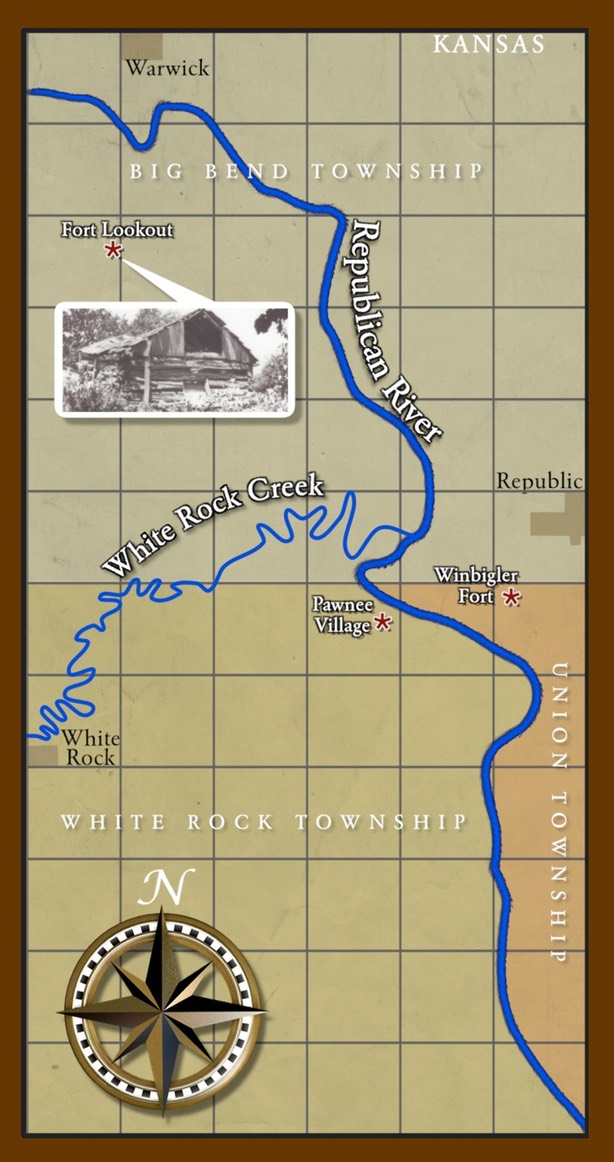A few days ago I mentioned coming across an item in the Daily Kansas Tribune from September 1868 about soldiers from Company “F” of the 5th Infantry “on their way toward White Rock creek to put up a block house” as a sanctuary for settlers during Indian attacks. An 1870 map listing military forts in Kansas and Nebraska shows a prominent cross marking a spot north of the creek labeled “Block House,” unmistakable evidence that the soldiers had accomplished their mission. Perhaps.
Dave Lovewell dropped me a note to say that the only military structure in the area he knew about was "Fort Lookout” which was situated three miles southeast of Hardy, Nebraska, in a field in western Republic County, Kansas. I looked up a current map of the area and overlaid it on the 1870 drawing. The cross on the 1870 map lies precisely three miles southeast of present-day Hardy. Thanks to Dave I now had a name for the frontier sanctuary, and a quick web search turned up information about its history, even a few pictures. The best of these can be found on larrypapenfuss.org/fortlookout/. There are three on kansasmemory.org, and while these are disappointingly washed-out prints, they do show views of the site from three separate angles, as it appeared shortly after the turn of the 20th century. Even back then this relic of warfare on the Plains was in pathetic shape.

It had been built as a classic two-story blockhouse, a larger upper level perched on a pillbox cabin, a design we sometimes recognize in bastions overlooking the gates of frontier stockades. As an added measure of protection, the second story was built cater-cornered with the bottom level, giving defenders eight possible angles for firing at attackers through small notches in the log walls. What happened to the old fortress was exactly what seemed inevitable from looking at any picture of a blockhouse. As the supporting timbers decayed, the top-heavy structure colllapsed, squishing the lower level into a pile of rubble. What remained as a recognizable building at the start of the 20th century was mostly the upper-level, now resting on a woodpile.
Various stories about Fort Lookout give us a picture of the blockhouse, imagined as an early-day guardian of the military road between Fort Kearny and Fort Riley, built at the start of the Civil War, perhaps even a year earlier.
An item in the Courtland Journal in 1976 contains a much-earlier interview with a Republic County pioneer named J. C. Price, who speculated that the fort must have been completed after 1859, since a government survey begun that year did not mention it as a landmark. When Price arrived in the county in 1870, he was told that it had been abandoned by the Army two or three years earlier.
One history of the station confidently gives its date of construction as 1860. Another says it “obviously” must have been in place by the outbreak of hostilities between Blue and Gray in 1861. The Larry Papenfuss website declares that the blockhouse went up in 1866. A book called “Kansas Forts and Bases: Sentinels on the Prairie” accepts 1861 as the date of construction, and 1868 as the year it was abandoned by the military and turned over to local militias for protection during Indian uprisings. The book recounts its one confirmed use - as the shelter where a group of buffalo hunters from Waterville spent the evening of May 25 and the early hours of May 26, 1869, before all but one were slaughtered by Cheyenne Dog Soldiers as they tried to cross a swollen Republican River and make tracks for home.
It should be possible to prove or disprove the story that it was an Army installation, built to protect the military road. Fort Lookout was an effective guardian only when manned by a garrison of soldiers, and so far I’ve found no indication that it ever was. The Army loved paperwork, and if soldiers were stationed at the fort we should find a sheaf of neatly-ruled post returns for a place called “Lookout Station” or something similar, between 1861 and 1868. It was probably not, as I once speculated, the site where Gordon Winbigler died in 1868. County historian Isaac Savage pinpoints the location of the refuge which Winbigler came so very close to reaching in the nick of time, and I’ve marked it on the map above. Haying parties along the meadows of the Republican River in the parched August of 1868 probably headed for something closely resembling a real fort - several log cabins arranged in a rectangular perimeter, which may have been connected by a small stockade.
Aside from pure speculation, I know of three pieces of hard evidence concerning the history of the ruined fort in Republic County: an 1870 map, a survivor’s story from 1869, and a letter from Lake Sibley dated September 5, 1868. My own guess is that “Fort Lookout” was hurriedly thrown together by a company of carpenters from the 5th Infantry in September of 1868, a few weeks after Cheyenne raiders swept through the region. The letter printed in the Daily Kansas Tribune announced that soldiers were on their way to White Rock Creek to do just that. If they didn’t build the blockhouse that appeared three miles north of the creek, what were they doing there?